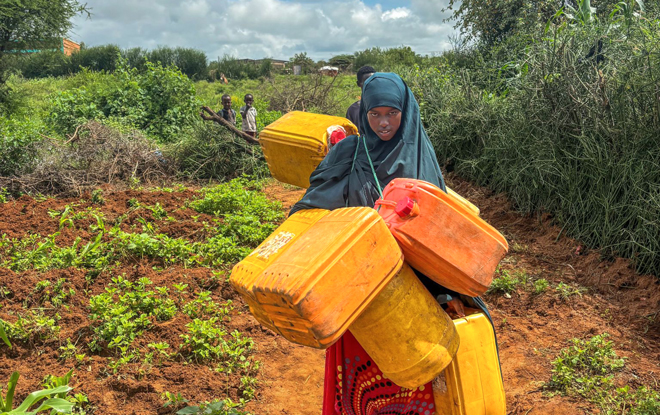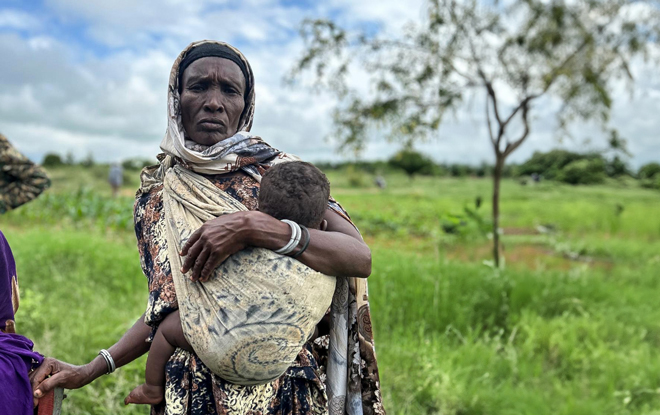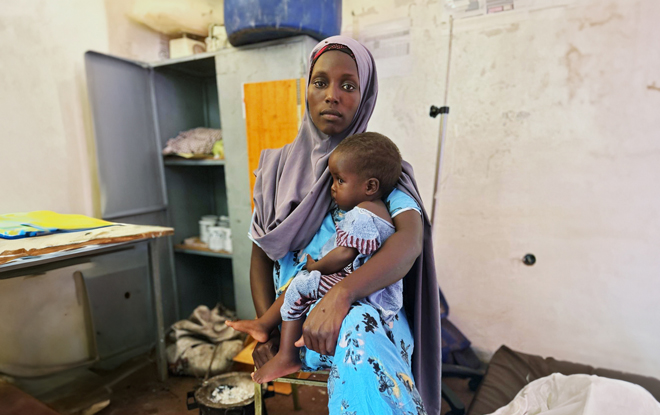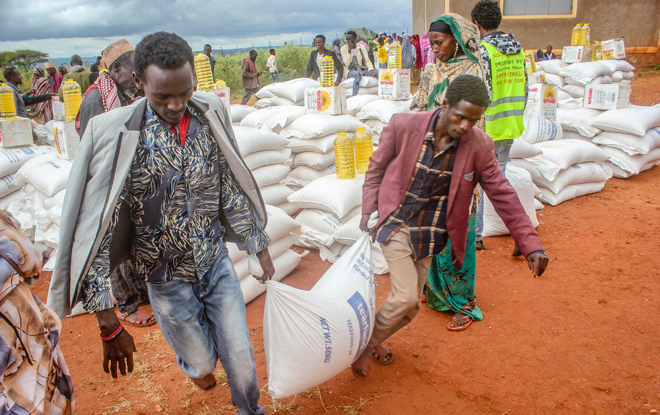A Forgotten Hunger
9239 0
Freddie Mercury and Queen stole the show. In July 1985, multiple musicians, linked via satellite, sang to raise funds for 8 million Ethiopian famine victims. Forty percent of the world tuned in to watch. Twenty-one minutes of the broadcast was pure Freddie. Freddie mainlining electric energy in tight white pants, strutting a stage he owned, scorching the air with his phenomenal four-octave vocals. Queen’s set is still considered the most iconic live gig in history.
Live Aid raised £150 million. Resulting publicity helped provide surplus grain to end the immediate hunger crisis. Up to 1.2 million Ethiopians died.
Fast forward forty years. There are no benefit concerts now for Ethiopia. The world has not noticed a much larger catastrophe: 20 million people at risk of famine. The IPC (Integrated Food Security Phase Classification) scale is at 4 - ‘Emergency/Critical’, indicating high levels of child malnutrition and community food insecurity. Phase 5 is ‘Catastrophe/Famine’. Famines are not purely natural disasters, but rather the consequence of human action, or inaction.
A team of five Kiwis - two from Tearfund NZ, two from Newshub, and myself - travel to southern Ethiopia, a stone’s throw from the Kenyan border, to see and hear stories of unimaginable hunger. What we see is confronting. I feel horrified. A deep shame that I knew nothing about this. Currently, USAID is supporting 115,000 people in this area, but 667,000 need emergency meals. Tearfund wants to raise NZ $750,000 to help. MFAT (New Zealand’s Ministry of Foreign Affairs and Trade) has promised to match aid agencies, dollar for dollar, as part of a combined $7m commitment to the region. A live-saving miracle.
Donate now
Ethiopia is a wondrous place. One of the oldest civilisations in the world, never colonised, despite Italian occupation for six years by fascist boots and spaghetti. The birthplace of coffee: rich, dark, with a treacly tug. A place that runs on an ancient 13-month calendar and 12-hour day. Her inhabitants smile readily; there is an easy camaraderie between strangers, a cheeky banter between men and women.

A girl carrying jerry cans as she goes to collect water. Photo: Lisette Reymer
Ethiopia is also host to a complex ethnic make-up. Conflicts have skittered across her sandy face for centuries. There is some high-level corruption; tighter checks on aid have been put in place. Like neighbouring countries in the Horn of Africa, Ethiopia is susceptible to the ravages of drought. In the early 1900s, droughts happened every 10 years. In the last 30 years, every 4 years. In the last decade, nearly every year. According to the World Meteorological Organisation, temperatures have been rising in Africa by +0.3 °C/decade since the 1990s, more than the world average. Africans produce only 1 metric tonne per capita of greenhouse gases, while the rest of the world produces almost 5. Yet Africa suffers the most.
Right now, in southern Ethiopia alone, 20% of children aged 6 months to 5 years have global acute malnutrition. I think of the awful consequences - the death of a child, a parent’s universe severed from meaning; and of how survivors also suffer, succumbing to chronic disease later in life, poor IQ, lost productivity. Children cannot help where they are born.
Half of all pregnant and breast-feeding women in this area, and half of the elderly, are also acutely malnourished. Herders have lost 85% of livestock, in a land where animals are not just a source of food, but are life itself, a proxy marker of social standing.
Why have we not heard more about this?
This is very much a forgotten hunger. The twin horrors of Gaza and Ukraine saturate the air waves. A cynical calculation is that it takes 50 African lives to be as newsworthy as a single white person’s life. The Ethiopian political machinery is reluctant to acknowledge the F word – famine.
Donate now

Currently, one in six people in Ethiopia need emergency food aid. Photo: Dr Himali McInnes
We fly south from the capital Addis Ababa in the slim tube of a Bombardier, then travel by car for 6 hours. The road is spear-straight and cuts through a wide, low, flat land. Distant mountains smudge with purplish kohl. Early on, we weave through a Noah’s Ark of creatures on the tarmac. Camels purse their lips with disapproval and stare with heavy-lidded eyes. Trips of goats chew with sooty snouts. Donkeys sulk past bearing massive loads. As we reach our destination, some 600km away, the livestock vanishes into thin air.
We travel with Tearfund’s Ethiopian partner agency. The team are incredibly knowledgeable, politically astute, passionate about helping their country. With funding, they will buy food, bypassing the government and delivering directly to the needy. They also want to build resilient communities, via sourcing drought-resistant food crops, teaching farmers better agricultural practices, procuring replacement livestock, lobbying for improved irrigation. Famine, they insist, should not be an unrelenting, Sisyphean calamity.
There has been rain, a spattering of it here and there. Just a bridal train of moisture really, filmy and scant, after 5 years of unrelenting drought. Hardy acacias, spiky with thorns and meagre of juice, are the only trees tough enough to survive. The ground is desiccated, sifts under my shoes fine as icing sugar. The next dry season looms, just one month away.

Dikosuke and her baby. She had 37 cows, only two remain, her situation is desperate. Photo: Dr Himali McInnes
A local man, Abdul Karima, hobbles over. He is one hundred years old. He leans forward from the hips and totters with a cane. His face is thin, stony with sadness.
‘I have lost all my animals, all ten of my children have died. We depend now on food aid and we feel hopeless. I am suffering in old age and I am complaining to God.’
A little girl called Nasra lies on a mat. She is the sallow colour of quicksand, her mouth grimacing, her arm flung over her eyes, too tired to play. Nasra is 6 but has the stunted stature of chronic malnutrition, and I wonder if she will survive. Inside a round hut with a steepled thatch roof, 40-year-old Bonne lies on a plinth. She has tuberculosis (TB), and is so emaciated her facial skin clings to the contours of her skull. The only movement inside the hut are the flies crawling on her. Malnutrition is a valkyrie that welcomes severe, often fatal disease in her wake. Another woman, 30 years old and swaddled in a bright pink shawl, squats on the ground. She too has TB and is stick-thin; I estimate her weight to be 35 kilos or less. She recently buried her one-year-old child, dead from starvation. She thinks her TB drugs may not be working.
Amo Isaac wears a black shawl and the stance of a woman with mana. She used to own 50 cows, and sold milk and butter to make up to 3000 birr (NZ $12) per week. The recurrent droughts have killed all but 2 of her animals. Now she collects firewood to make just 30 birr (87 cents) a day. ‘The drought has levelled everybody,’ she says with a sad smile.

Saida aged 2 years with her mother. She has cheeks and legs puffy with the dough-like swelling from malnutrition. Photo: Dr Himali McInnes
I visit a local medical clinic. There is a pharmacist, a lab technician, some nurses. A delivery room has some battered brown beds with stirrups. A pair of gumboots sits near a sink; they have witnessed blood and meconium, pale electric lights in the middle of the night, the thin wails of the newly born. In the next room, small patients sleep on mattresses next to their mothers. Saida, aged 2, has cheeks and legs puffy with the dough-like swelling of kwashiorkor (indicating severe acute malnutrition). She’s been treated with antibiotics, and fed. Her weight has improved from 9 kilos to 10, yet this is still several kilos short of a healthy peer. She sits like a stone angel in her mother’s arms, staring at nothing. On an adjacent mat, one-year-old Sudaisi weighed just 6 kilos at admission, and has gained one kilo with treatment. I ask about the mothers - are they getting enough to eat? There is an embarrassed silence; Ethiopian children get fed first, then the men, and lastly the women. The women don’t like to complain. The concavity of the mothers’ cheeks, the way their clothes hang on them, is my answer.

Baby Sudaisi weighed just 6kg on admission to the clinic, and has gained 1kg in the month since treatment but it’s not enough. Photo: Dr Himali McInnes
Most people in these communities are eating just one meal of ground maize per day, mixed to a bland porridge with water. Eating only untreated corn can lead to pellagra, a complex disease causing diarrhoea, dermatitis and dementia. In another village, I am thrilled to meet children giggling and posing for photos. The older ones try out their scant stock of English phrases on me: ‘How are you?’ Or ‘We are African.’ They cluster together and clap and sing us a song. Despite their vivacious smiles, they too are gaunt, with brittle brown hair, facial skin stretched drum-tight, stick-like arms. The one visible richness they have is community, yet there is no doubt that these children are very hungry.

Maize and oil being delivered because of Tearfund donations last year. Photo: Tearfund Canada
When just NZ $150 can feed one family for one month, it is wholly feasible that the massive loss of human life in Ethiopia can and must be averted.
Donate now
This article was first published by the NZ Herald.
Read our latest blogs to learn more about Ethiopia's forgotten crisis.
Uncovering Ethiopia’s Silent Struggle
Avoiding Famine in East Africa